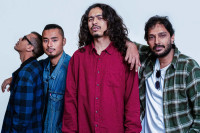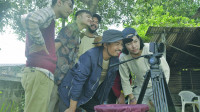Entertainment
All funked up
What the Funk, comprising seasoned musicians from KJC, inject groove and soul into both the classics and the band’s originals to create bopping, popping tunes
Nhooja Tuladhar
“We came together because we wanted to try something different,” says Yakthumba, who is also the bass player of the widely acclaimed rock band 1974 A. D. “The basic idea was to play funk and have a good time while we were at it.” The band, formed about 18 months ago, is working on a full-length album at the KJC studio, and I have been invited to sit in.
Band members claim that they have a very casual approach to songwriting—but that might be just a self-effacing explanation for how they go about their business. In Gai Jatra, for instance, the lyrics compare the country’s state to a perennially ongoing Gai Jatra. “The song is about the confused state of our nation. We can do almost anything during the day of the festival, and the same thing is happening in Nepal,” says Yakthumba.
The song Kathmandu is another example of the band’s keeping an eye on the larger society they are a part of.
In it, the Capital is compared to a young adolescent: “Kathmandu, where the hell are you going, don’t ya know ain’t nobody there. You’ve grown up to be quite the crazy fellow, strolling with your long shabby dirty hair...” The song works because although the band does probe the nature of the state’s transitional and undefined condition, it has not attempted to be preachy about the situation in any way. “Kathmandu is growing and that’s exciting, but it is unaware of where it wants to go,” says Yakthumba, as he attempts to talk about how the chaotic city can be understood by personifying it. “It could end up being a doctor or an engineer, but it’s not sure about it yet. I mean, it’s not really that bad and we aren’t implying anything through our lyrics. It’s just what it is.”
But not all the tracks on the album probe the here and now. The band has also been performing funk versions of Nepali as well as classic hits by local and international artistes. Sanjha Ko Jun, which was originally performed by Arun Thapa, has been turned into what could be called a
‘sexier’ cover.
The Thapa version, a popular classic, had its roots in rock, and the original was later put through the grinder by Mukti and Revival in their cover, which featured hard-hitting percussions and distorted guitars. What the Funk have revived Thapa’s tune by taking a different tack: by employing low trombone notes and a groovy bass line. And Mukhiya manages to breathe even more soul into the number through the expressiveness in his vocals, as he flits quickly between some very high notes and those of a very low timbre. Another classic that is being included in the album is Drive My Car, a much-covered Beatles number: the band basically funkifies the light-hearted original into a groovier one.
Performing cover songs and turning them into groovy tracks has definitely allowed the band to rope in new listeners into their world of funk.
“The types of covers that we do allow us to rework the originals through a different perspective, and that probably allows the audience to view things from a new angle as well,” says guitarist Lama.
Funky albums are rather new to most Nepali listeners because until now funk has mostly only been used as a sub-genre that Nepali artists incorporate in their music. Songs by the Axe band, for example, include super-funky guitar pieces, but they do so without including a dominant bass, something that might have upped the funk-factor of their songs. Very rarely have artists in Nepal stuck with old-school style funk rhythms in the manner of What the Funk. And that’s why What the Funk is getting the kind of reception they deserve. “The crowds get pretty amazed,” says Lama. “And then they start dancing,” adds Yakthumba.




 30.01°C Kathmandu
30.01°C Kathmandu










